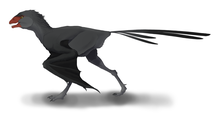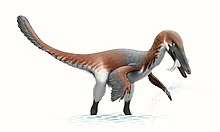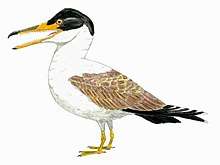Omnivoropterygidae
Omnivoropterygidae (meaning "omnivorous wings") is a family of primitive avialans known exclusively from the Jiufotang Formation of China. They had short skeletal tails and unusual skulls with teeth in the upper, but not lower, jaws. Their unique dentition has led some scientists to suggest an omnivorous diet for them.[1] The family was named by Stephen A. Czerkas & Qiang Ji in 2002, though its junior synonym Sapeornithidae is often used instead, though it was named four years later in 2006.[2] It is the only named family in the order Omnivoropterygiformes.
| Omnivoropterygids | |
|---|---|
| Fossil specimen of Sapeornis chaoyangensis, Hong Kong Science Museum | |
| Scientific classification | |
| Kingdom: | Animalia |
| Phylum: | Chordata |
| Clade: | Dinosauria |
| Clade: | Saurischia |
| Clade: | Theropoda |
| Clade: | Avebrevicauda |
| Family: | †Omnivoropterygidae Czerkas & Ji, 2002 |
| Type species | |
| †Omnivoropteryx sinousaorum Czerkas & Ji, 2002 | |
| Genera | |
| Synonyms | |
| |
References
- Czerkas, S. A. & Ji, Q. (2002). "A preliminary report on an omnivorous volant bird from northeast China." In: Czerkas, S. J. (editor): Feathered Dinosaurs and the origin of flight. The Dinosaur Museum Journal 1: 127-135. HTML abstract
- Hu, D., Li, L., Hou, L., and Xu, X. (2010). "A new sapeornithid bird from China and its implication for early avian evolution." Acta Geologica Sinica, (English Edition) 84(3): 472-482. doi:10.1111/j.1755-6724.2010.00188.x
This article is issued from Wikipedia. The text is licensed under Creative Commons - Attribution - Sharealike. Additional terms may apply for the media files.



.png)





.png)


